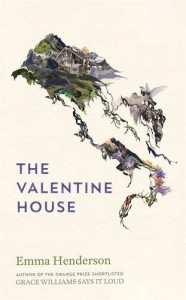 Published by Sceptre 6 April 2017
Published by Sceptre 6 April 2017
352pp, hardback, £16.99
Reviewed by Alison Burns
Emma Henderson’s unusual, tender (Independent on Sunday) and exuberant (Daily Express) first novel, Grace Williams Says It Loud (2010), was acclaimed for many reasons, not least for its ‘sure command of a singular voice’ (Boyd Tonkin, Independent Books of the Year). It was the story of an inner life.
Her second novel, The Valentine House, again gives us strongly-sensed characters, each of which (although two in particular) has her or his own passionate inner life which Henderson revels in revealing. Inspired by the six years Henderson spent in a remote valley in the French Alps, The Valentine House takes its vantage point from a chalet she came across high in the mountains – built in 1858 by Sir Alfred Wills, British mountaineer and judge – and draws on the owner’s writings. The first of Henderson’s main characters – Anthony Valentine, scholarly patriarch of the family’s adored chalet, Arete – grew from these experiences and discoveries. The second, his servant Mathilde, is entirely Henderson’s creation, and into her the author seems to have poured everything she knows and feels about this magical region and its real-life occupants.
This is a long book, with a large cast, covering a long span of years, with much movement back and forth in time. It is intricately plotted. It is also utterly disarming.
The narrative starts with a bang, as Anthony Valentine gives vent to his erotic passion for the landscape. He writes in his library, in private, expressing an almost laughable obsession (certainly his descendants find it funny). From here, we are introduced to a family story full of secrets and scandals, spanning more than a hundred years of history.
Mathilde is the same age as the century. It is 1914 when she first enters Arete as a member of the household’s summer staff. She has seen it before several times, as a child, when, with her schoolfriend and champion Benoit and his father Tall Paul, she took produce from her father’s farm to the chalet kitchen. Cross-eyed, hunchbacked, short, she is known as one of the local ‘uglies’. Mathilde may be odd-looking but she has a fierce intelligence, which is nurtured by her other lifelong champion, the schoolmistress Mme Tissot.
The scene is set for an entrancing story of life in two worlds, across decades of change from the 1860s to the 1970s. In one world, privileged visitors spend glorious summers mountaineering, playing games, dancing and having affairs. In the other, the arduous farming year rolls through its seasons. Each world has its share of hardship and heartbreak, and in both worlds there is a profound intimacy with the landscape for those who are alert to its charms.
Alliances are made between the two social strata, despite their differences. For example, Mathilde is adopted for a long while as her best friend by the bored and wayward young Daisy Valentine. In the previous century, it was Daisy’s grandfather who was particularly devoted to Xavier, the mountain guide. In both time-frames, a great deal more turns out to have been going on than at first meets the eye. World wars, the Jazz Age, electrification and tourism bring profound change and eventually some people leave the valley – but not Mathilde.
Henderson’s novel captures impeccably the process whereby a loved physical world creeps under the skin and stays there. Anyone who has experienced this will recognize especially Mathilde’s relationship with the land. It also pays out the rope of explanation in tantalizing stages, as observant Mathilde, over a period of seventy years, pieces together the confusing pieces of the Valentine world.
